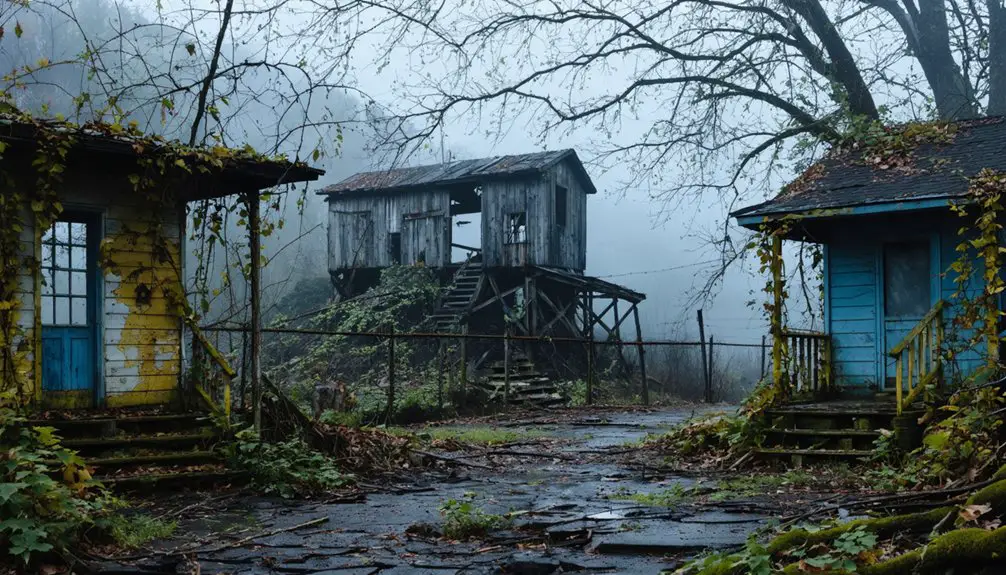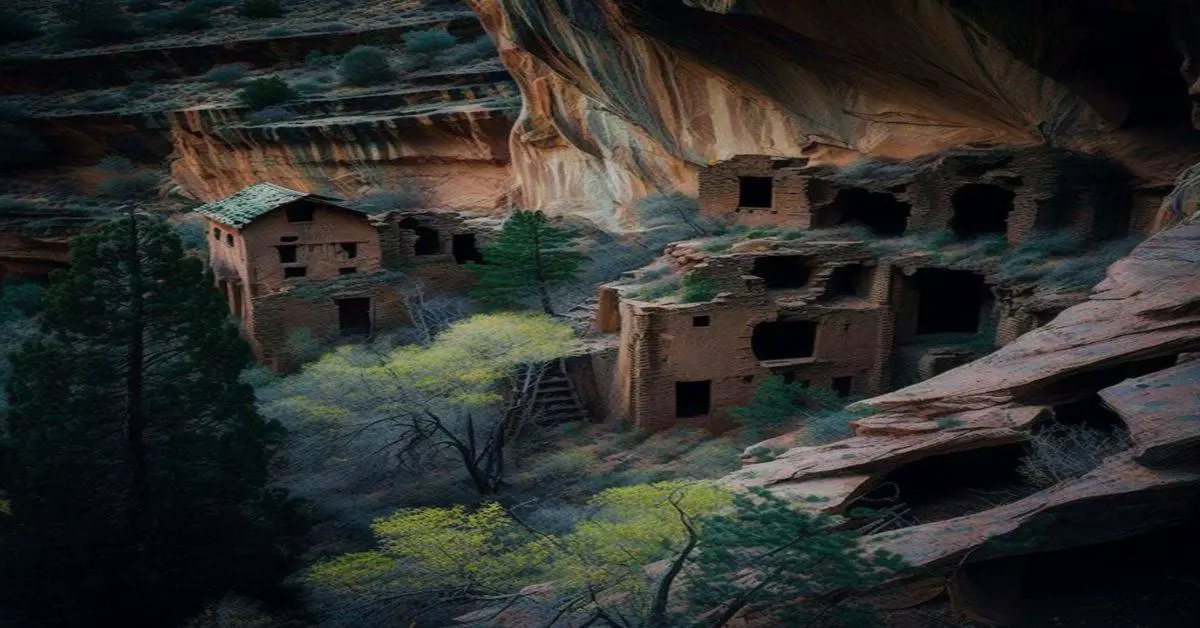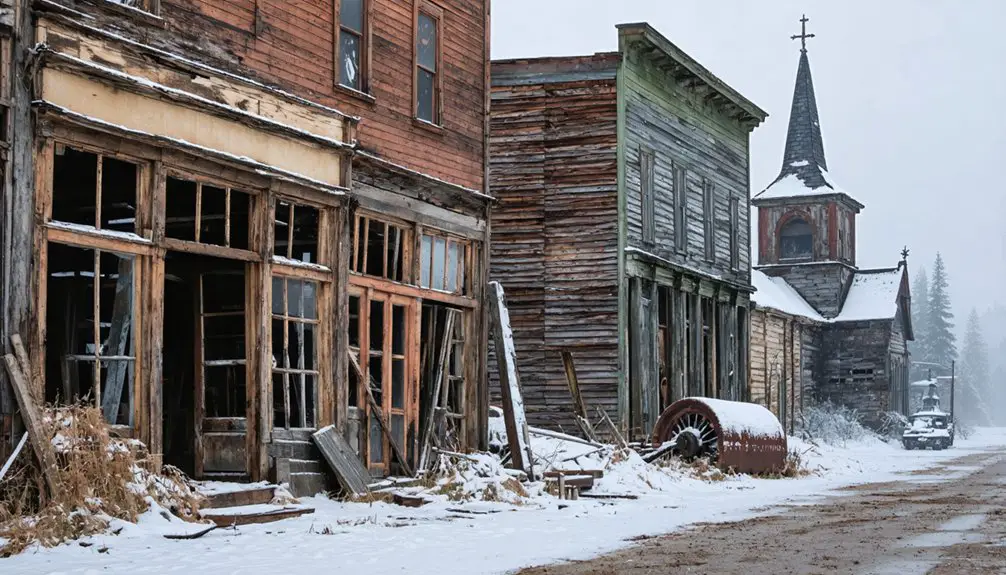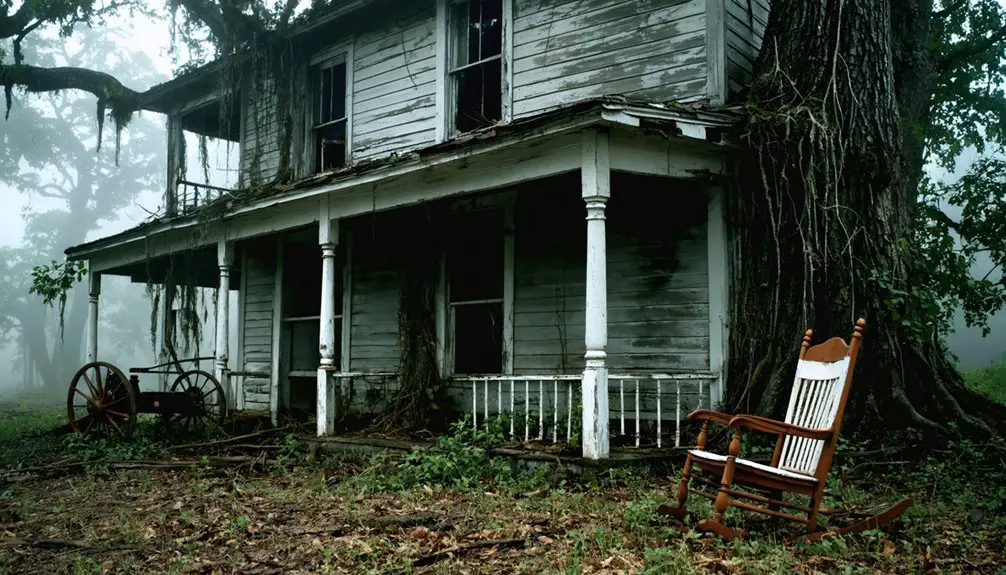You’ll find Putney’s ghost town remains along Campbells Creek in West Virginia, where it thrived as a coal mining settlement from 1902 until 1948. The town grew rapidly around Mine #1 and Mine #3 after the Campbells Creek Railroad’s arrival, with Alexander Moseley Putney’s company store at its heart. Today, scattered ruins and overgrown landscapes tell the story of this once-bustling community’s rise and fall, marking an important chapter in West Virginia’s industrial transformation.
Key Takeaways
- Putney became a ghost town after Mine #3 closed in 1948, marking the end of its coal mining era.
- The town developed around two major mining operations and the Campbells Creek Railroad, which arrived in 1902.
- Company stores operated on scrip currency, creating financial dependence that contributed to the town’s eventual economic collapse.
- Fires destroyed major landmarks, while the shift from rail to automobile transportation accelerated Putney’s decline.
- Today, only scattered ruins and overgrown landscape remain, with preservation efforts focusing on protecting structures and maintaining cemeteries.
The Birth of a Coal Mining Settlement
While coal was first discovered in West Virginia as early as 1742, it wasn’t until 1902 that the town of Putney emerged as a bustling coal mining settlement. The arrival of the Campbells Creek Railroad line transformed this once-quiet area into a thriving community, marking a significant shift in local settlement patterns.
Named after Alexander Moseley Putney, who operated the community company store, the town quickly developed around two major mining operations: Company #1 mine in Putney and Mine #3 at Mill Hollow.
You’ll find that the rapid coal discovery in this region sparked swift development of miner housing and essential businesses. Like many mining communities, workers were often paid in company store scrip. The Campbells Creek Coal Company controlled much of the land and mining rights, establishing the infrastructure that would define Putney’s character as a classic early 20th-century mining town. The area experienced significant growth during the 1920s when poor road conditions made the railroad the primary mode of transportation for both miners and other passengers.
Railroad’s Arrival and Town Development
You’ll find that Putney’s transformation began in 1902 when the Campbells Creek Railroad extended its tracks to serve the emerging coal mining settlement.
Similar to how True Putney provided stone for railroad construction, the railroad’s arrival spurred rapid economic growth as the Campbells Creek Coal Company established its operations, particularly around Mines #1 and #3.
The company town quickly took shape along the tracks with miners’ homes, loading facilities, and Alexander Moseley Putney’s store becoming central features of the settlement. Like many West Virginia railroad towns of the era, Putney benefited from the efficient transportation system that enabled the movement of coal and other goods.
Railroad Construction Timeline
Several pivotal railroad developments shaped Putney’s growth, beginning with the Chesapeake & Ohio Railway‘s completion in 1873.
You’ll find this was a transformative moment, as the C&O’s final spike at Hawks Nest connected the eastern seaboard to southern West Virginia’s coalfields, spurring rapid railroad expansion throughout the region. The rapid growth of railroads in the area mirrored George Gould’s vision of creating a transcontinental railroad system through strategic acquisitions and new construction.
This expansion mirrored the ambitious growth seen in other regions, like the Richmond & Danville Railroad which had established crucial rail connections across Virginia and the Southeast in 1856.
Economic Growth Spurs Settlement
As the Campbells Creek Railroad extended its reach to Putney in 1902, the small settlement rapidly transformed into a bustling mining town.
You’d have witnessed the immediate emergence of economic opportunities as mines #1 and #3 opened their operations, drawing significant labor migration to the area.
The railroad’s arrival sparked an infrastructure boom that shaped Putney’s character.
You would’ve seen company stores, miners’ homes, and supporting businesses spring up along the tracks.
Similar to how passenger service operated between Romney and Moorefield in 1910, the railroad became vital for transporting both workers and goods to support the growing community.
Alexander Moseley Putney’s company store became a central hub for both commerce and community life.
The carefully planned integration of rail facilities, including wyes and tipples, enabled efficient coal movement from the mines to river ports.
This strategic development created a self-sustaining cycle where railroad prosperity and mining success reinforced each other, establishing Putney as a thriving early 20th-century mining community.
Like the West Virginia Midland Railroad, Putney’s development was closely tied to the availability of natural resources that drove its economic growth.
Camp Layout Along Tracks
The railroad’s arrival in 1902 prompted a strategically planned camp layout along the tracks at Putney.
You’ll find evidence of careful railroad integration throughout the town’s design, with mining architecture positioned for maximum efficiency. Similar to the Davis Coal and Coke Company, the local mines depended heavily on rail transport for distribution. The company store, offices, and miners’ housing were arranged close to the tracks, creating a classic early 20th-century mining community.
Mill Hollow’s wye facilitated locomotive turning, while Mine #3 and Mine #1 were positioned for ideal coal transport.
You can trace how the town developed linearly along the rail corridor, with tipples and loading points placed directly beside the tracks. Housing clusters and businesses spread outward from this central transportation axis, reflecting the period’s typical coal town hierarchy where proximity to rail determined both social and operational structure.
Life in the Company Town
You’d find life in Putney revolved around Alexander Moseley Putney’s company store, where miners relied on credit and faced controlled pricing that often led to crushing debt.
The mining company owned the workers’ homes and dictated living conditions, creating a system of dependency that extended far beyond the workplace.
After grueling shifts in the mines, workers navigated a social structure heavily influenced by company policies, which regulated everything from church attendance to leisure activities.
Like many towns in the region, Putney’s economy shifted from early salt production operations to coal mining as industrial demands evolved.
Company Store Economics
Located at the heart of Putney’s coal mining operations, company stores dominated both economic and social life through a complex system of scrip-based commerce.
You’d find everything from basic groceries to mining equipment, but this convenience came at a steep price. The scrip system effectively locked you into shopping at the company store, as your wages came in the form of company-issued tokens rather than cash.
While prices weren’t always inflated due to worker mobility and union influence, the system created deep financial dependence. You could get credit advances against future wages, but this often led to the infamous cycle of debt captured in the phrase “I owe my soul to the company store.”
As automobiles and mail-order catalogs emerged, they gradually weakened the company store’s iron grip on local commerce.
Housing Under Mining Control
Beyond the economic control of company stores, living arrangements in Putney fell squarely under mining company dominion through an extensive network of company-built housing.
You’d find yourself living in one of the hastily constructed wooden frame houses, built for efficiency rather than comfort, clustered near the mine entrances.
The company’s housing control extended beyond mere shelter – they’d deduct rent directly from your wages and monitor your daily activities.
Your cramped living space would offer basic amenities at best, with unreliable sanitation and water services controlled by the company.
This system deepened miners’ dependence, as you couldn’t own or modify your home.
If you dared to unionize or protest working conditions, you’d risk eviction.
The company’s grip on housing served as a powerful tool to maintain control over workers’ lives, limiting their ability to seek better opportunities elsewhere.
Social Structure After Work
While the grueling work in Putney’s mines dominated daily life, a distinct social structure emerged during off-hours that centered around the company store and limited recreational spaces.
You’d find social interactions tightly controlled through Alexander Moseley Putney’s company store, where workers gathered to share news and conversation while acquiring goods on credit.
During evenings and weekends, you could join community gatherings like picnics, dances, or religious events, though these were often company-sponsored to maintain loyalty.
Your recreational options remained limited to card games, storytelling, and church activities.
If you were a miner, you’d likely participate in fraternal organizations that provided mutual aid and insurance benefits, offering some security against workplace hazards while strengthening communal bonds across ethnic and regional lines.
Mining Operations and Working Conditions
The mining operations in Putney flourished after the 1902 extension of Campbells Creek Railroad, with Mine #1 and Mine #3 at Mill Hollow becoming the area’s primary coal producers.
You’d find miners working around the clock in dangerous conditions, facing constant mining hazards like cave-ins, poor air quality, and the ever-present threat of black lung disease.
The work was brutally demanding, with miners loading coal into steel hoppers at a relentless pace. Labor strikes emerged as workers fought against low wages and unsafe conditions, though coal companies strongly resisted these efforts.
The mines stripped the surrounding landscape bare of timber, while underground, ventilation remained a persistent problem despite legislative attempts to regulate air quality.
Mine #3 continued operations until 1948, marking the end of Putney’s coal era.
The Role of the Company Store
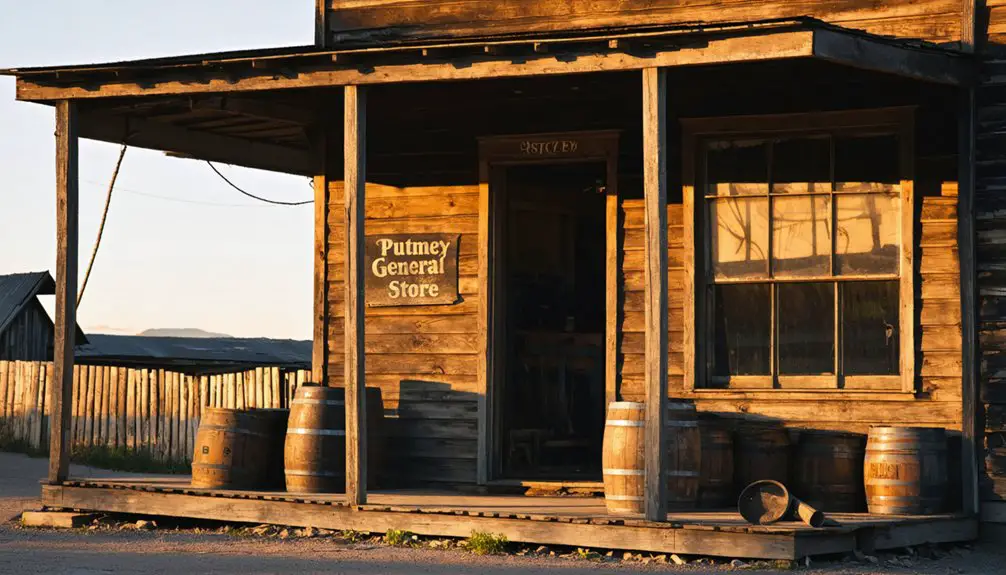
Located strategically near major roads, Putney’s company store served as more than just a retail establishment – it functioned as the epicenter of economic and social control in the mining community.
Through retail monopoly and scrip currency, the store, operated by Alexander Moseley Putney, effectively bound workers to company-controlled commerce while housing essential services like the post office and payroll department.
- Workers could only spend their earnings at the store using company-issued scrip
- The store marked up prices considerably, increasing company profits
- During economic downturns, the store remained open to maintain control
- As the community hub, it shaped social practices and cultural norms
- The building’s architecture reflected the company’s cultural influence, reinforcing its dominance
The store’s company store functions extended beyond commerce – it was a calculated instrument of corporate power that shaped every aspect of miners’ lives.
Community and Social Structure
Spanning several decades in the early 1900s, Putney’s social fabric reflected the complex dynamics of an Appalachian coal and railroad town, where economic stratification and ethnic diversity shaped daily life.
You’d find a community divided between mine owners and laborers, yet united through shared institutions like churches and schools that fostered social resilience.
Despite economic hardships, community dynamics thrived through multi-generational family bonds and gender-specific roles. Men worked the mines and railways while women maintained households and community connections.
Through hardship and tradition, families held fast – men to their labor underground, women to hearth and home above.
You’d witness social life centered around church gatherings, school functions, and local fairs, with informal clubs strengthening the town’s social networks.
Outside town limits, a parallel economy of gambling and entertainment venues emerged, highlighting the complex social structure that defined this working-class Appalachian community.
The Decline Years
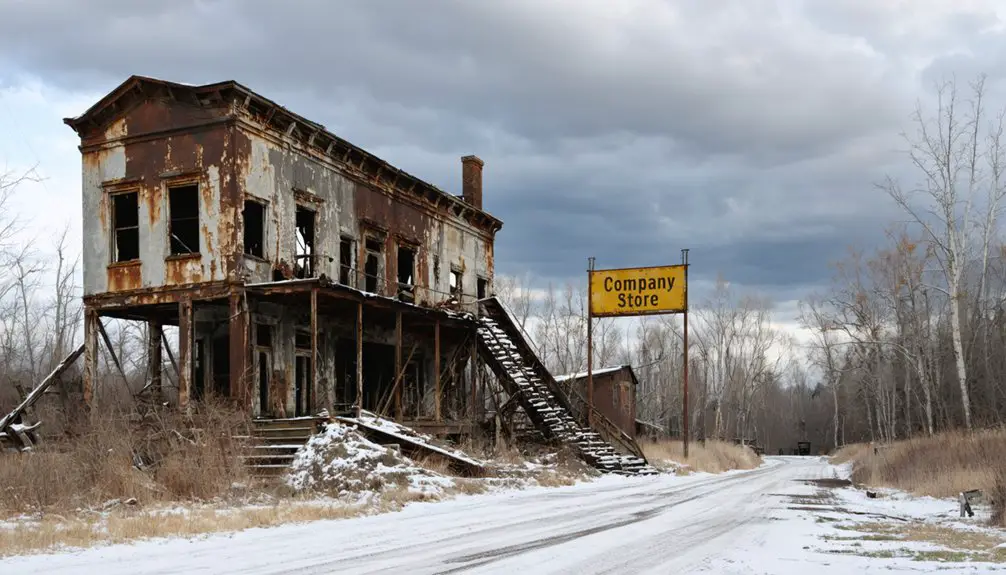
During the mid-20th century, Putney’s decline accelerated through a perfect storm of economic and social changes that would ultimately seal its fate.
You’ll find a town that suffered from devastating economic downturns as railroad activity diminished and infrastructure neglect took hold. The rise of automobiles and improved highways dealt a crushing blow to Putney’s railroad-dependent economy, while multiple disasters, including fires, destroyed critical buildings and dampened hopes for recovery.
- Fire destroyed major landmarks, including hotels that served as economic anchors
- Shift from rail to automobile transportation diverted essential commerce
- Prohibition laws shut down lucrative vice-related businesses
- Diesel locomotives reduced coal transport, eliminating key revenue streams
- Population exodus left buildings abandoned and deteriorating
Physical Remains and Ghost Town Status
You’ll find scattered ruins of former miners’ homes and company buildings throughout Putney’s overgrown landscape, with stone foundations and partial walls marking where structures once stood.
The town’s original grid layout remains visible through old roadbeds and building footprints, though nature has reclaimed much of the space between them.
Railroad remnants and abandoned mine entrances anchor the site’s industrial heritage, while deteriorating wooden structures provide glimpses into the daily lives of Putney’s former residents.
Structural Ruins Today
Most of Putney’s surviving structures lie in ruins today, with only scattered remnants of the once-thriving coal mining town still visible.
You’ll find decay patterns typical of abandoned West Virginia coal camps, where nature steadily reclaims what humans left behind. These ghostly remnants include crumbling foundations, partial walls, and occasional rusting mining equipment hidden beneath forest growth.
- Deteriorating masonry and wooden framework from company-built housing
- Overgrown ruins of former coal company buildings and infrastructure
- Moss and ivy-covered foundation stones scattered throughout the site
- Rusted mining equipment partially buried under decades of forest debris
- Weathered outlines of the company store location, barely visible among vegetation
Town Layout Remnants
The original layout of Putney now exists primarily as faint traces in the landscape, with the town’s physical footprint having largely disappeared beneath natural growth.
You’ll find little evidence of the town planning that once shaped this small Appalachian community, as sparse documentation and minimal historical mapping make it challenging to reconstruct the original street grid or block patterns.
Unlike some of West Virginia’s more prominent ghost towns, Putney’s remnants don’t include substantial ruins or preserved structures.
The post office that once served as a community hub has closed, and the surrounding area has reverted to forest and farmland.
What you’re seeing today is nature’s reclamation of a settlement that, like many rural communities in the region, gradually faded into obscurity.
Legacy in West Virginia’s Industrial Heritage
While many coal towns faded into obscurity, Putney’s legacy endures as a prime example of West Virginia’s industrial evolution during the early 20th century.
You’ll find its economic transformation mirrored the state’s broader industrial heritage, where coal mining emerged alongside established iron and salt industries. The town’s rapid development after 1902 showcases how railroad infrastructure and company operations shaped West Virginia’s industrial landscape.
- The Campbells Creek Railroad’s arrival in 1902 sparked Putney’s swift transformation
- Company stores and mining infrastructure exemplified vertical integration common in coal towns
- Railroad facilities connected Putney’s mines to wider markets through the Dana port
- The town’s development pattern reflects the boom-and-bust cycle of resource-dependent communities
- Putney’s industrial legacy connects to the region’s earlier iron and salt manufacturing history
Preserving Putney’s Story
Preserving Putney’s historical legacy requires coordinated efforts across multiple fronts, from physical conservation to digital archiving.
You’ll find community initiatives working to protect remaining structures, maintain cemeteries, and install interpretive signage that tells the town’s story. Historical preservation efforts include collecting oral histories from former residents and digitizing photographs from the early 1900s.
Local schools now incorporate Putney’s history into their curriculum, while historical organizations create educational materials and host guided tours.
You can explore the town’s past through documentary videos, virtual tours, and online archives. Despite challenges like limited funding and natural decay, dedicated preservationists continue documenting Putney’s contribution to West Virginia’s industrial heritage through archival records, photographs, and maps of the once-thriving coal mining community.
Frequently Asked Questions
Are There Any Surviving Photos of Putney During Its Peak Years?
You’ll find one remarkable piece of photographic evidence: a 1903 image showing locomotive Number 3 with loaded hoppers, preserved in the Rebecca Putney Morgan/Todd A. Hanson collection – highlighting its historical significance.
What Happened to the Mining Equipment After the Town Was Abandoned?
You’ll find most mining equipment remained where it stood, rusting and decaying in the elements. The abandoned machinery gradually merged with the forest landscape, too large and costly to salvage or relocate.
Did Any Notable Accidents or Disasters Occur in Putney’s Mines?
Playing it close to the vest, you won’t find records of major mining tragedies in Putney’s mines, despite the era’s limited safety regulations. Small accidents likely occurred but weren’t officially documented.
Where Did Most of Putney’s Former Residents Relocate To?
You’ll find that migration patterns followed job opportunities, with most residents moving to active mining regions in West Virginia and neighboring states, while others sought new community dynamics in larger industrial cities.
Is It Legal to Visit and Explore Putney’s Remains Today?
With 75% of ghost town exploration requiring landowner permission, you’ll need to verify property ownership and obtain consent to legally visit Putney’s remains or risk trespassing charges.
References
- https://www.youtube.com/watch?v=yBKOIRxeNX0
- https://www.youtube.com/watch?v=-EeLwLa2t90
- https://kids.kiddle.co/List_of_ghost_towns_in_West_Virginia
- https://www.wvncrails.org/campbells-creek-railroad.html
- https://en.wikipedia.org/wiki/Putney
- https://www.legendsofamerica.com/west-virginia-coal-mining/
- https://minesafety.wv.gov/historical-statistical-data/mining-in-west-virginia-a-capsule-history/
- https://www.averyreview.com/issues/35/making-coal-historical
- https://archives.lib.wvu.edu/subjects/180
- https://granitehistoricalsociety.org/?p=592
